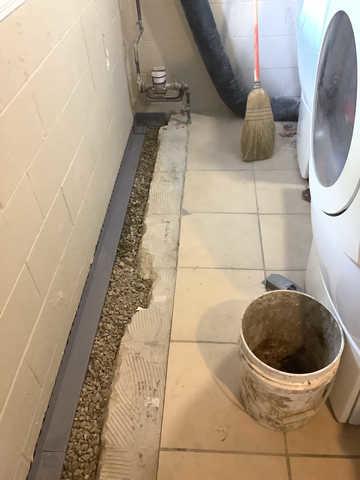
Crawlspace and Basement Waterproofing
The WaterGuard solution is designed to control perimeter water from the cove joint and redirect that water to a sump pit. We jackhammered out the concrete along the perimeter, and hauled away the concrete and related debris. We then dug a trench and drilled weep holes (in block walls), . We then laid out filter cloth to minimize sediment getting into system, and installed the WaterGuard system (including clean-out ports) on foundation footing. We backfilled those areas with river rock stone, then mortared back the floor. To help mitigate water in the dirt crawlspace and redirect to a discharge system, we dug trenches along the perimeter of the crawlspace and laid out filter cloth in those trenches to minimize sediment getting into system. We installed four-inch drain tile with 3/4" holes, and backfilled the trenched areas with stone, and connected the drain tile to discharge-system sump pit.
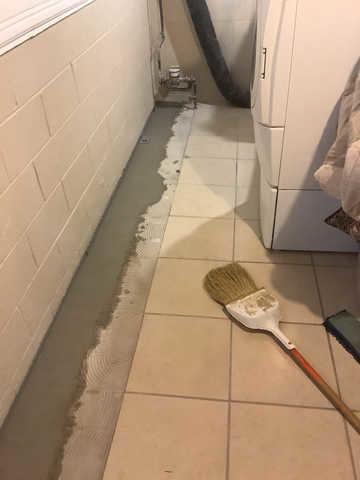
Crawlspace and Basement Waterproofing
The WaterGuard solution is designed to control perimeter water from the cove joint and redirect that water to a sump pit. We jackhammered out the concrete along the perimeter, and hauled away the concrete and related debris. We then dug a trench and drilled weep holes (in block walls), . We then laid out filter cloth to minimize sediment getting into system, and installed the WaterGuard system (including clean-out ports) on foundation footing. We backfilled those areas with river rock stone, then mortared back the floor. To help mitigate water in the dirt crawlspace and redirect to a discharge system, we dug trenches along the perimeter of the crawlspace and laid out filter cloth in those trenches to minimize sediment getting into system. We installed four-inch drain tile with 3/4" holes, and backfilled the trenched areas with stone, and connected the drain tile to discharge-system sump pit.

Crawlspace and Basement Waterproofing
The WaterGuard solution is designed to control perimeter water from the cove joint and redirect that water to a sump pit. We jackhammered out the concrete along the perimeter, and hauled away the concrete and related debris. We then dug a trench and drilled weep holes (in block walls), . We then laid out filter cloth to minimize sediment getting into system, and installed the WaterGuard system (including clean-out ports) on foundation footing. We backfilled those areas with river rock stone, then mortared back the floor. To help mitigate water in the dirt crawlspace and redirect to a discharge system, we dug trenches along the perimeter of the crawlspace and laid out filter cloth in those trenches to minimize sediment getting into system. We installed four-inch drain tile with 3/4" holes, and backfilled the trenched areas with stone, and connected the drain tile to discharge-system sump pit.

Crawlspace and Basement Waterproofing
The WaterGuard solution is designed to control perimeter water from the cove joint and redirect that water to a sump pit. We jackhammered out the concrete along the perimeter, and hauled away the concrete and related debris. We then dug a trench and drilled weep holes (in block walls), . We then laid out filter cloth to minimize sediment getting into system, and installed the WaterGuard system (including clean-out ports) on foundation footing. We backfilled those areas with river rock stone, then mortared back the floor. To help mitigate water in the dirt crawlspace and redirect to a discharge system, we dug trenches along the perimeter of the crawlspace and laid out filter cloth in those trenches to minimize sediment getting into system. We installed four-inch drain tile with 3/4" holes, and backfilled the trenched areas with stone, and connected the drain tile to discharge-system sump pit.
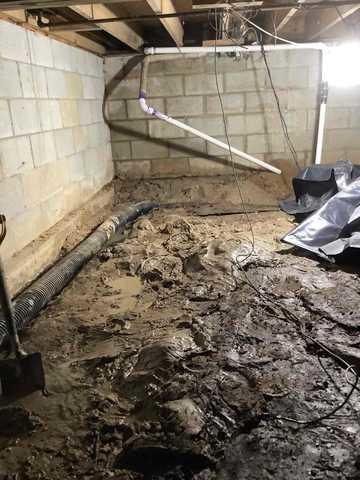
Crawlspace and Basement Waterproofing
The WaterGuard solution is designed to control perimeter water from the cove joint and redirect that water to a sump pit. We jackhammered out the concrete along the perimeter, and hauled away the concrete and related debris. We then dug a trench and drilled weep holes (in block walls), . We then laid out filter cloth to minimize sediment getting into system, and installed the WaterGuard system (including clean-out ports) on foundation footing. We backfilled those areas with river rock stone, then mortared back the floor. To help mitigate water in the dirt crawlspace and redirect to a discharge system, we dug trenches along the perimeter of the crawlspace and laid out filter cloth in those trenches to minimize sediment getting into system. We installed four-inch drain tile with 3/4" holes, and backfilled the trenched areas with stone, and connected the drain tile to discharge-system sump pit.
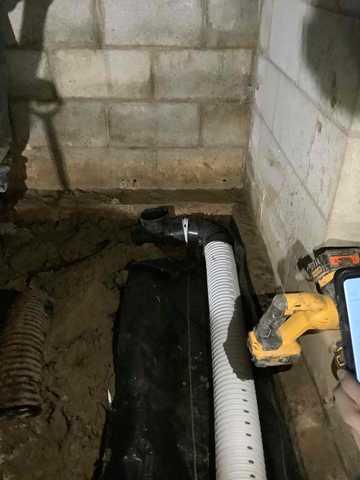
Crawlspace and Basement Waterproofing
The WaterGuard solution is designed to control perimeter water from the cove joint and redirect that water to a sump pit. We jackhammered out the concrete along the perimeter, and hauled away the concrete and related debris. We then dug a trench and drilled weep holes (in block walls), . We then laid out filter cloth to minimize sediment getting into system, and installed the WaterGuard system (including clean-out ports) on foundation footing. We backfilled those areas with river rock stone, then mortared back the floor. To help mitigate water in the dirt crawlspace and redirect to a discharge system, we dug trenches along the perimeter of the crawlspace and laid out filter cloth in those trenches to minimize sediment getting into system. We installed four-inch drain tile with 3/4" holes, and backfilled the trenched areas with stone, and connected the drain tile to discharge-system sump pit.
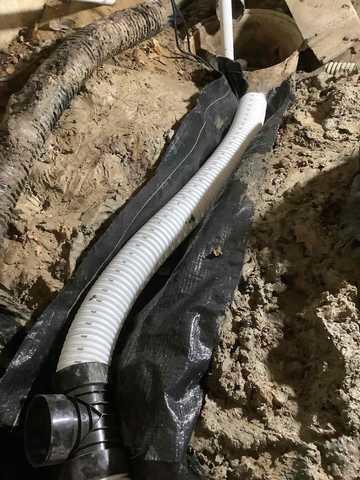
Crawlspace and Basement Waterproofing
The WaterGuard solution is designed to control perimeter water from the cove joint and redirect that water to a sump pit. We jackhammered out the concrete along the perimeter, and hauled away the concrete and related debris. We then dug a trench and drilled weep holes (in block walls), . We then laid out filter cloth to minimize sediment getting into system, and installed the WaterGuard system (including clean-out ports) on foundation footing. We backfilled those areas with river rock stone, then mortared back the floor. To help mitigate water in the dirt crawlspace and redirect to a discharge system, we dug trenches along the perimeter of the crawlspace and laid out filter cloth in those trenches to minimize sediment getting into system. We installed four-inch drain tile with 3/4" holes, and backfilled the trenched areas with stone, and connected the drain tile to discharge-system sump pit.

Crawlspace and Basement Waterproofing
The WaterGuard solution is designed to control perimeter water from the cove joint and redirect that water to a sump pit. We jackhammered out the concrete along the perimeter, and hauled away the concrete and related debris. We then dug a trench and drilled weep holes (in block walls), . We then laid out filter cloth to minimize sediment getting into system, and installed the WaterGuard system (including clean-out ports) on foundation footing. We backfilled those areas with river rock stone, then mortared back the floor. To help mitigate water in the dirt crawlspace and redirect to a discharge system, we dug trenches along the perimeter of the crawlspace and laid out filter cloth in those trenches to minimize sediment getting into system. We installed four-inch drain tile with 3/4" holes, and backfilled the trenched areas with stone, and connected the drain tile to discharge-system sump pit.
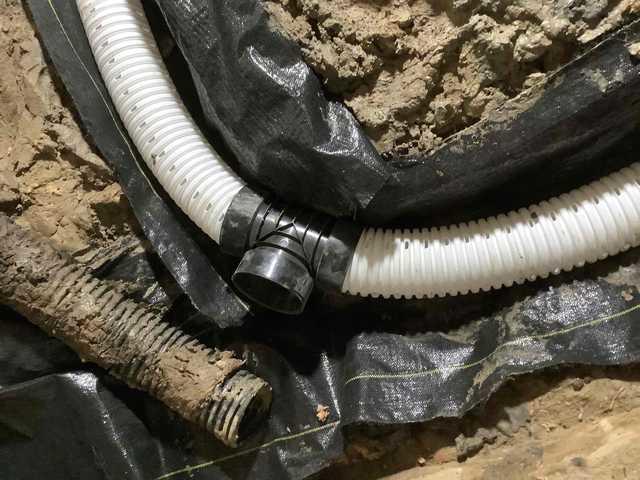
Crawlspace and Basement Waterproofing
The WaterGuard solution is designed to control perimeter water from the cove joint and redirect that water to a sump pit. We jackhammered out the concrete along the perimeter, and hauled away the concrete and related debris. We then dug a trench and drilled weep holes (in block walls), . We then laid out filter cloth to minimize sediment getting into system, and installed the WaterGuard system (including clean-out ports) on foundation footing. We backfilled those areas with river rock stone, then mortared back the floor. To help mitigate water in the dirt crawlspace and redirect to a discharge system, we dug trenches along the perimeter of the crawlspace and laid out filter cloth in those trenches to minimize sediment getting into system. We installed four-inch drain tile with 3/4" holes, and backfilled the trenched areas with stone, and connected the drain tile to discharge-system sump pit.
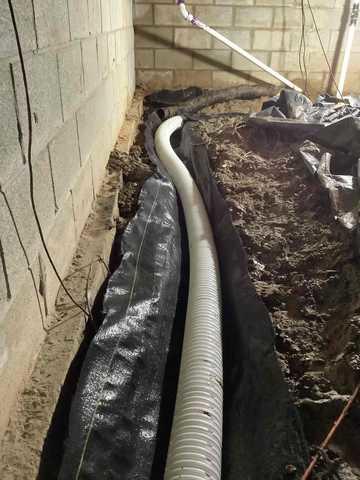
Crawlspace and Basement Waterproofing
The WaterGuard solution is designed to control perimeter water from the cove joint and redirect that water to a sump pit. We jackhammered out the concrete along the perimeter, and hauled away the concrete and related debris. We then dug a trench and drilled weep holes (in block walls), . We then laid out filter cloth to minimize sediment getting into system, and installed the WaterGuard system (including clean-out ports) on foundation footing. We backfilled those areas with river rock stone, then mortared back the floor. To help mitigate water in the dirt crawlspace and redirect to a discharge system, we dug trenches along the perimeter of the crawlspace and laid out filter cloth in those trenches to minimize sediment getting into system. We installed four-inch drain tile with 3/4" holes, and backfilled the trenched areas with stone, and connected the drain tile to discharge-system sump pit.

Crawlspace and Basement Waterproofing
The WaterGuard solution is designed to control perimeter water from the cove joint and redirect that water to a sump pit. We jackhammered out the concrete along the perimeter, and hauled away the concrete and related debris. We then dug a trench and drilled weep holes (in block walls), . We then laid out filter cloth to minimize sediment getting into system, and installed the WaterGuard system (including clean-out ports) on foundation footing. We backfilled those areas with river rock stone, then mortared back the floor. To help mitigate water in the dirt crawlspace and redirect to a discharge system, we dug trenches along the perimeter of the crawlspace and laid out filter cloth in those trenches to minimize sediment getting into system. We installed four-inch drain tile with 3/4" holes, and backfilled the trenched areas with stone, and connected the drain tile to discharge-system sump pit.
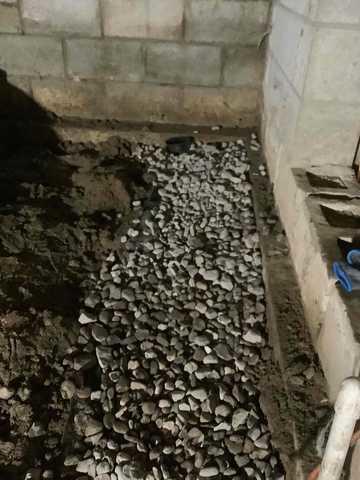
Crawlspace and Basement Waterproofing
The WaterGuard solution is designed to control perimeter water from the cove joint and redirect that water to a sump pit. We jackhammered out the concrete along the perimeter, and hauled away the concrete and related debris. We then dug a trench and drilled weep holes (in block walls), . We then laid out filter cloth to minimize sediment getting into system, and installed the WaterGuard system (including clean-out ports) on foundation footing. We backfilled those areas with river rock stone, then mortared back the floor. To help mitigate water in the dirt crawlspace and redirect to a discharge system, we dug trenches along the perimeter of the crawlspace and laid out filter cloth in those trenches to minimize sediment getting into system. We installed four-inch drain tile with 3/4" holes, and backfilled the trenched areas with stone, and connected the drain tile to discharge-system sump pit.
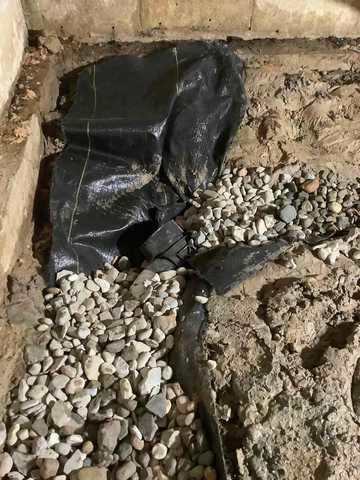
Crawlspace and Basement Waterproofing
The WaterGuard solution is designed to control perimeter water from the cove joint and redirect that water to a sump pit. We jackhammered out the concrete along the perimeter, and hauled away the concrete and related debris. We then dug a trench and drilled weep holes (in block walls), . We then laid out filter cloth to minimize sediment getting into system, and installed the WaterGuard system (including clean-out ports) on foundation footing. We backfilled those areas with river rock stone, then mortared back the floor. To help mitigate water in the dirt crawlspace and redirect to a discharge system, we dug trenches along the perimeter of the crawlspace and laid out filter cloth in those trenches to minimize sediment getting into system. We installed four-inch drain tile with 3/4" holes, and backfilled the trenched areas with stone, and connected the drain tile to discharge-system sump pit.
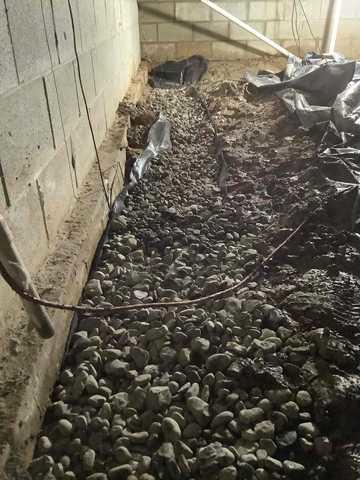
Crawlspace and Waterproofing
The WaterGuard solution is designed to control perimeter water from the cove joint and redirect that water to a sump pit. We jackhammered out the concrete along the perimeter, and hauled away the concrete and related debris. We then dug a trench and drilled weep holes (in block walls), . We then laid out filter cloth to minimize sediment getting into system, and installed the WaterGuard system (including clean-out ports) on foundation footing. We backfilled those areas with river rock stone, then mortared back the floor. To help mitigate water in the dirt crawlspace and redirect to a discharge system, we dug trenches along the perimeter of the crawlspace and laid out filter cloth in those trenches to minimize sediment getting into system. We installed four-inch drain tile with 3/4" holes, and backfilled the trenched areas with stone, and connected the drain tile to discharge-system sump pit.
